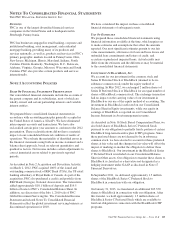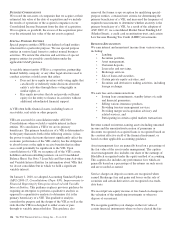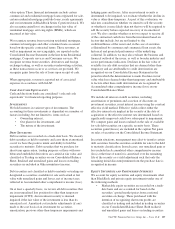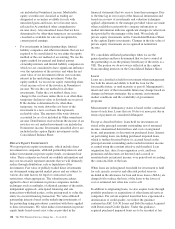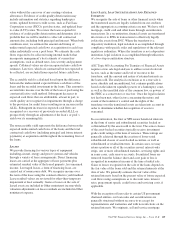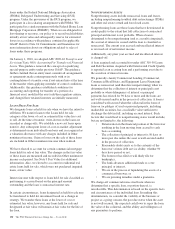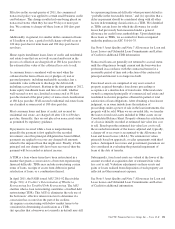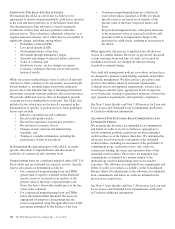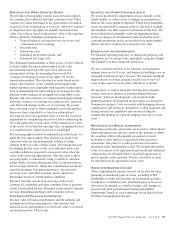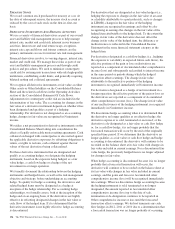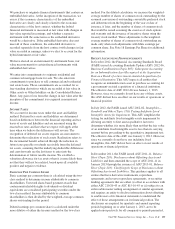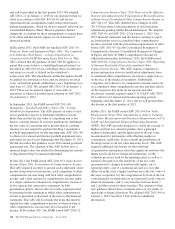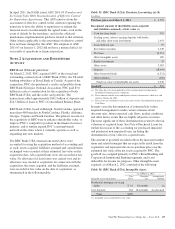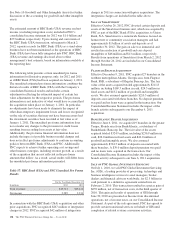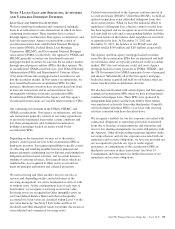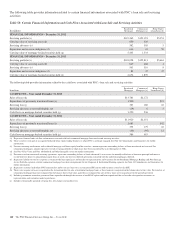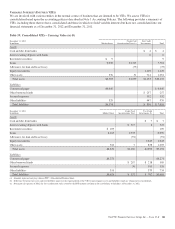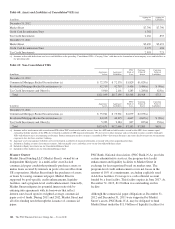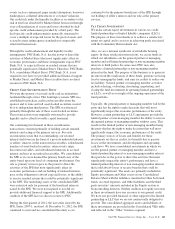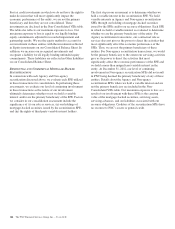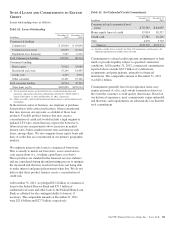PNC Bank 2012 Annual Report Download - page 154
Download and view the complete annual report
Please find page 154 of the 2012 PNC Bank annual report below. You can navigate through the pages in the report by either clicking on the pages listed below, or by using the keyword search tool below to find specific information within the annual report.We purchase or originate financial instruments that contain an
embedded derivative. At the inception of the transaction, we
assess if the economic characteristics of the embedded
derivative are clearly and closely related to the economic
characteristics of the host contract, whether the hybrid
financial instrument is measured at fair value with changes in
fair value reported in earnings, and whether a separate
instrument with the same terms as the embedded derivative
would be a derivative. If the embedded derivative does not
meet all of these conditions, the embedded derivative is
recorded separately from the host contract with changes in fair
value recorded in earnings, unless we elect to account for the
hybrid instrument at fair value.
We have elected on an instrument-by-instrument basis, fair
value measurement for certain financial instruments with
embedded derivatives.
We enter into commitments to originate residential and
commercial mortgage loans for sale. We also enter into
commitments to purchase or sell commercial and residential
real estate loans. These commitments are accounted for as
free-standing derivatives which are recorded at fair value in
Other assets or Other liabilities on the Consolidated Balance
Sheet. Any gain or loss from the change in fair value after the
inception of the commitment is recognized in noninterest
income.
I
NCOME
T
AXES
We account for income taxes under the asset and liability
method. Deferred tax assets and liabilities are determined
based on differences between the financial reporting and tax
bases of assets and liabilities and are measured using the
enacted tax rates and laws that we expect will apply at the
time when we believe the differences will reverse. The
recognition of deferred tax assets requires an assessment to
determine the realization of such assets. Realization refers to
the incremental benefit achieved through the reduction in
future taxes payable or refunds receivable from the deferred
tax assets, assuming that the underlying deductible differences
and carryforwards are the last items to enter into the
determination of future taxable income. We establish a
valuation allowance for tax assets when it is more likely than
not that they will not be realized, based upon all available
positive and negative evidence.
E
ARNINGS
P
ER
C
OMMON
S
HARE
Basic earnings per common share is calculated using the two-
class method to determine income attributable to common
shareholders. Unvested share-based payment awards that
contain nonforfeitable rights to dividends or dividend
equivalents are considered participating securities under the
two-class method. Income attributable to common
shareholders is then divided by the weighted-average common
shares outstanding for the period.
Diluted earnings per common share is calculated under the
more dilutive of either the treasury method or the two-class
method. For the diluted calculation, we increase the weighted-
average number of shares of common stock outstanding by the
assumed conversion of outstanding convertible preferred stock
and debentures from the beginning of the year or date of
issuance, if later, and the number of shares of common stock
that would be issued assuming the exercise of stock options
and warrants and the issuance of incentive shares using the
treasury stock method. These adjustments to the weighted-
average number of shares of common stock outstanding are
made only when such adjustments will dilute earnings per
common share. See Note 18 Earnings Per Share for additional
information.
R
ECENT
A
CCOUNTING
P
RONOUNCEMENTS
In October 2012, the Financial Accounting Standards Board
(FASB) issued Accounting Standards Update (ASU) 2012-06,
Business Combinations (Topic 805): Subsequent Accounting
for an Indemnification Asset Recognized at the Acquisition
Date as a Result of a Government-Assisted Acquisition of a
Financial Institution. This ASU impacts all entities that
recognize an indemnification asset in purchase accounting for
a government-assisted acquisition of a financial institution.
The effective date of ASU 2012-06 was January 1, 2013.
However, since we currently do not have any of these assets,
this ASU did not have an effect on our results of operations or
financial position.
In July 2012, the FASB issued ASU 2012-02, Intangibles—
Goodwill and Other (Topic 350): Testing Indefinite-Lived
Intangible Assets for Impairment. This ASU simplifies the
testing for indefinite lived intangible assets impairment by
allowing an entity to first assess qualitative factors to
determine whether it is more likely than not that the fair value
of an indefinite lived intangible asset is less than its carrying
amount before proceeding to the quantitative impairment test.
The effective date of this ASU was January 1, 2013. However,
since we currently do not have any indefinite lived
intangibles, this ASU did not have an effect on our results of
operations or financial position.
In December 2011, the FASB issued ASU 2011-11, Balance
Sheet (Topic 210): Disclosures about Offsetting Assets and
Liabilities and then amended the scope of ASU 2011-11 in
January 2013 through the issuance of ASU 2013-01, Balance
Sheet (Topic 210): Clarifying the Scope of Disclosures about
Offsetting Assets and Liabilities. This guidance applies to all
entities that have derivative instruments, repurchase
agreements and reverse repurchase agreements, or securities
lending agreements that are either (i) offset in accordance with
either ASC 210-20-45 or ASC 815-10-45 or (ii) subject to an
enforceable master netting arrangement or similar agreement,
and requires an entity to disclose information about offsetting
to enable users of its financial statements to understand the
effect of those arrangements on its financial position. The
disclosures are required for quarterly and annual reporting
periods beginning on or after January 1, 2013, are to be
applied retrospectively for all comparative periods presented,
The PNC Financial Services Group, Inc. – Form 10-K 135


